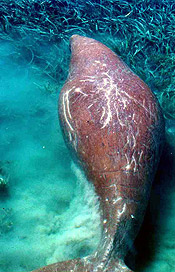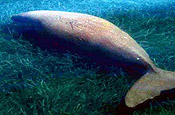
Research Projects – Dugongs

Dugongs

Dugongs are often called sea cows, but there are more like sea pigs - they prefer to root out nutritious stems of seagrass (rhizomes) that lie below the sediment rather than croping seagrass leaves. Dugongs are voracious eaters, consuming enough seagrass when feeding in groups to alter the structure of entire meadows. Therefore, understanding how dugongs choose when, where, and how to forage is important to protecting dugongs, seagrasses, and the many species that use seagrass beds for food or shelter.
Thus far, most studies have focused on the relationship between dugongs and their food while ignoring the role that predators might play in the lives of these seagrass specialists. In contrast, our aim in the Eastern Gulf of Shark Bay has been to determine whether the danger of tiger shark attack has implications for the way dugongs forage and, indirectly, for Shark Bay’s expansive sea grass meadows. Below, you will find information on our studies on dugongs. For more information on the effects of dugong foraging on seagrass beds see our seagrass research page and to learn about how the tiger shark-dugong relationship might structure seagrass beds go to our indirect effects of tiger sharks page.
How Do We Study Dugong Behavior?


Since 1997, we have been monitoring the abundance and habitat choices of dugongs within fourteen 3-4.5-km long, 200m (~650') wide sample zones (transects) positioned in deep and shallow habitats throughout our study area offshore of Monkey Mia. Seven are in deep habitats (6-12m; 20-40') where there is little seagrass and seven are in shallow habitats (1.5-4m; 4-14') that are covered almost entirely with seagrass. Starting in 2006 we added four additional transects that run along the edges of seagrass banks. To sample a zone, we drive along a transect line in the middle of the zone at 6-9km/hr and we record the position and behavior (traveling, resting or foraging) of every dugong we see surfacing within 100m of the boat. Using these data and information on the diving behavior of dugongs we can calculate the number and density of dugongs in each zone. As of January 2009, we have completed almost 4,000 passes through our transects.
We collect more detailed information on the foraging behavior, movements, and diving behavior of dugongs with focal animal follows from our small (4.5m, 15') boats. Although dugongs are shy animals, by driving slowly and cautiously, we are able to remain close enough to the dugongs to record, in detail, their activities without disturbing them - even when they are under the water. For instance, we can see whether or not a dugong is digging at the rhizomes of seagrass (excavation foraging) or simply cropping off the tops of the leaves- a significant difference when it comes to the beds' ability to recover and the ability of a dugong to see a tiger shark coming!
How do Tiger Sharks Influence Dugong Foraging Methods and Foraging Locations?

shallow seagrass beds, but use
them less when tiger sharks are in
the bay.

mother

Dugongs are not abundant in our study site all year. They are abundant during the Austral warm season (September – May) but are less common or even absent during colder months (June – August), probably because the water is too cold for them to forage efficiently. Regardless of their overall density, dugongs are most commonly encountered over shallow seagrass banks, where their food (seagrass) is most abundant. But we have found that dugongs modify their use of space and their behavior in response to tiger sharks.
- When there are few sharks, dugongs use the shallows much more often than deep areas. But, as tiger shark numbers increase, the dugongs spend less and less time in the shallows where tiger sharks prefer to hunt.
- Dugongs harvest seagrass either by rooting into the substrate (excavation) or by stripping the leaves (cropping). Excavation yields nutrient-rich rhizomes, but is dangerous because it impedes the detection of approaching predators; cropping is less energetically beneficial, but safer because individuals using this feeding tactic can scan for sharks. When sharks are scarce, dugongs are often found excavation foraging, but cropping is the favored tactic when danger abounds.
- While foraging over seagrass meadows, dugongs choose particular feeding sites based on the chances that they will be able to escape from an attacking shark. At first we were surprised to see that dugongs used the edges of seagrass banks more and more, relative to the interiors of banks, as tiger sharks became more abundant in the bay. With tiger sharks spending most of their time hunting along bank edges and seagrass along the edges of banks being of relatively low quality, dugongs were failing to avoid encountering their predators and passing on the best food. But, dugongs along the edges of banks can escape from tiger sharks more easily than those that run into a shark in the middle of the bank! In other words, just like dolphins, dugongs prefer to feed in areas where they have an easy time escaping from predators even if it means they see them more often. See our escape tactics research page for more information on how species responses to tiger sharks vary with how they can avoid an imminent attack.
Recently, we found that dugongs change the frequency at which they come to the surface when foraging depending on how abundant sharks are and what foraging tactic they are using. When sharks are abundant and it is most dangerous, dugongs that are excavating seagrasses come to the surface more often than they do when sharks are less abundant. Dugongs that are cropping the leaves of seagrasses don't change how they dive and surface in response to shark danger. We think that this is because dugongs that are excavating are at a greater risk from sharks because of the plume of sediment that forms and reduces their chances of seeing an approaching predator. To minimize this risk, they come to the surface where they can look around more often.
We’ve also recently found that dugongs alter the way they switch between behavioral states, like feeding, traveling, and resting, when in the presence of tiger sharks. When there are few tiger sharks around, dugongs foraging over shallow meadows spend long, uninterrupted spells harvesting seagrass. When they’re finished feeding, they then rest for long, uninterrupted bouts. When sharks are around, however, dugongs change their behavior, switching often between feeding and traveling (moving between feeding spots). With sharks present, dugongs also only take quick naps and frequently move from one resting place to another. We think that dugongs make these changes because long feeding and resting bouts make them prone to surprise attack by sharks, whereas more frequent traveling between feeding and resting spots allows dugong to survey their surroundings for sharks while they move and are not distracted.
Dugong Studies Publications
- Wirsing, A. J. and M. R. Heithaus. 2012. Behavioral transition probabilities in dugongs change with habitat and predato presence: implications for sirenian conservation. Marine and Freshwater Research 63: 1069-1076.
- Wirsing, A. J. and W. J. Ripple. 2011. A comparison of shark and wolf research reveals similar behavioral responses by prey. Frontiers in Ecology and the Environment 9: 335-341.
- Wirsing, A. J., M. R. Heithaus, and L. M. Dill. 2011. Predator-induced modifications to diving behavior very with foraging mode. Oikos 120: 1005-1012.
- Heithaus, M. R., A. J. Wirsing, D. Burkholder, J. Thomson, and L. M. Dill. 2009. Towards a predictive framework for predator risk effects: the interaction of landscape features and prey escape tactics. Journal of Animal Ecology 78: 556-562.
- Wirsing, A. J., M. R. Heithaus, A. Frid, and L. M. Dill. 2008. Seascapes of fear: methods for evaluation sublethal predator effects experienced and generated by marine ammals. Marine Mammal Science 24: 1-15.
- Heithaus, M. R. A. J. Wirsing, A. Frid, and L. M. Dill. 2007. Species interactions and marine conservation: lessons from an undisturbed ecosystem. Israel Journal of Ecology and Evolution 53: 355-370.
- Wirsing, A. J., M. R. Heithaus, and L. M. Dill. 2007. Living on the edge: dugongs prefer foraging microhabitats that allow escape rather than avoidance of predators. Animal Behaviour 74: 93-101.
- Wirsing, A. J., M. R. Heithaus, and L. M. Dill. 2007. Fear factor: Do dugogns (Dugong dugon) trade food for safety from tiger sharks (Galeocerdo cuvier)? Oecologia 153: 1031-1040.
- Wirsing, A. J., M. R. Heithaus, and L. M. Dill. 2007. Can you dig it? Use of excavation, a risky foraging tactic, by dugongs is sensitive to predation danger. Animal Behavior 74: 1085-1091.
- Wirsing, A. J., M. R. Heithaus, and L. M. Dill. 2007. Can measures of prey availability improve our ability to predict the abundance of large marine predators? Oecologia 153:563-568.
- Dill, L. M., M. R. Heithaus, and C. J. Walters. 2003. Behaviorally-mediated indirect species interactions in marine communities and their conservation implications. Ecology 84: 1151-11567.
- Heithaus, M. R., L. M. Dill, G. J. Marshall, and B. Buhleier. 2002. Habitat use and foraging behavior of tiger sharks (Galeocerdo cuvier) in a sea grass ecosystem. Marine Biology 140: 237-248
All photographs copyrighted; Images may be used for educational purposes. For use in other forms contact Mike Heithaus

